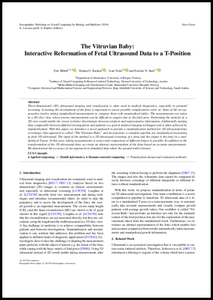Information
- Publication Type: Journal Paper with Conference Talk
- Workgroup(s)/Project(s):
- Date: September 2019
- Journal: Eurographics Workshop on Visual Computing for Biology and Medicine (2019)
- Volume: 9
- Lecturer: Eric Mörth
- Event: Eurographics Workshop on Visual Computing for Biology and Medicine (2019)
- DOI: 10.2312/vcbm.20191245
- Call for Papers: Call for Paper
- Conference date: 2019
- Pages: 201 – 205
Abstract
Three-dimensional (3D) ultrasound imaging and visualization is often used in medical diagnostics, especially in prenatal screening. Screening the development of the fetus is important to assess possible complications early on. State of the art approaches involve taking standardized measurements to compare them with standardized tables. The measurements are taken in a 2D slice view, where precise measurements can be difficult to acquire due to the fetal pose. Performing the analysis in a 3D view would enable the viewer to better discriminate between artefacts and representative information. Additionally making data comparable between different investigations and patients is a goal in medical imaging techniques and is often achieved by standardization. With this paper, we introduce a novel approach to provide a standardization method for 3D ultrasound fetus screenings. Our approach is called “The Vitruvian Baby” and incorporates a complete pipeline for standardized measuring in fetal 3D ultrasound. The input of the method is a 3D ultrasound screening of a fetus and the output is the fetus in a standardized T-pose. In this pose, taking measurements is easier and comparison of different fetuses is possible. In addition to the transformation of the 3D ultrasound data, we create an abstract representation of the fetus based on accurate measurements. We demonstrate the accuracy of our approach on simulated data where the ground truth is known.Additional Files and Images
Weblinks
BibTeX
@article{vitruvian_2019,
title = "The Vitruvian Baby: Interactive Reformation of Fetal
Ultrasound Data to a T-Position",
author = "Eric M\"{o}rth and Renata Raidou and Ivan Viola and Noeska
Natasja Smit",
year = "2019",
abstract = "Three-dimensional (3D) ultrasound imaging and visualization
is often used in medical diagnostics, especially in prenatal
screening. Screening the development of the fetus is
important to assess possible complications early on. State
of the art approaches involve taking standardized
measurements to compare them with standardized tables. The
measurements are taken in a 2D slice view, where precise
measurements can be difficult to acquire due to the fetal
pose. Performing the analysis in a 3D view would enable the
viewer to better discriminate between artefacts and
representative information. Additionally making data
comparable between different investigations and patients is
a goal in medical imaging techniques and is often achieved
by standardization. With this paper, we introduce a novel
approach to provide a standardization method for 3D
ultrasound fetus screenings. Our approach is called “The
Vitruvian Baby” and incorporates a complete pipeline for
standardized measuring in fetal 3D ultrasound. The input of
the method is a 3D ultrasound screening of a fetus and the
output is the fetus in a standardized T-pose. In this pose,
taking measurements is easier and comparison of different
fetuses is possible. In addition to the transformation of
the 3D ultrasound data, we create an abstract representation
of the fetus based on accurate measurements. We demonstrate
the accuracy of our approach on simulated data where the
ground truth is known. ",
month = sep,
journal = "Eurographics Workshop on Visual Computing for Biology and
Medicine (2019)",
volume = "9",
doi = "10.2312/vcbm.20191245",
pages = "201--205",
URL = "https://www.cg.tuwien.ac.at/research/publications/2019/vitruvian_2019/",
}


